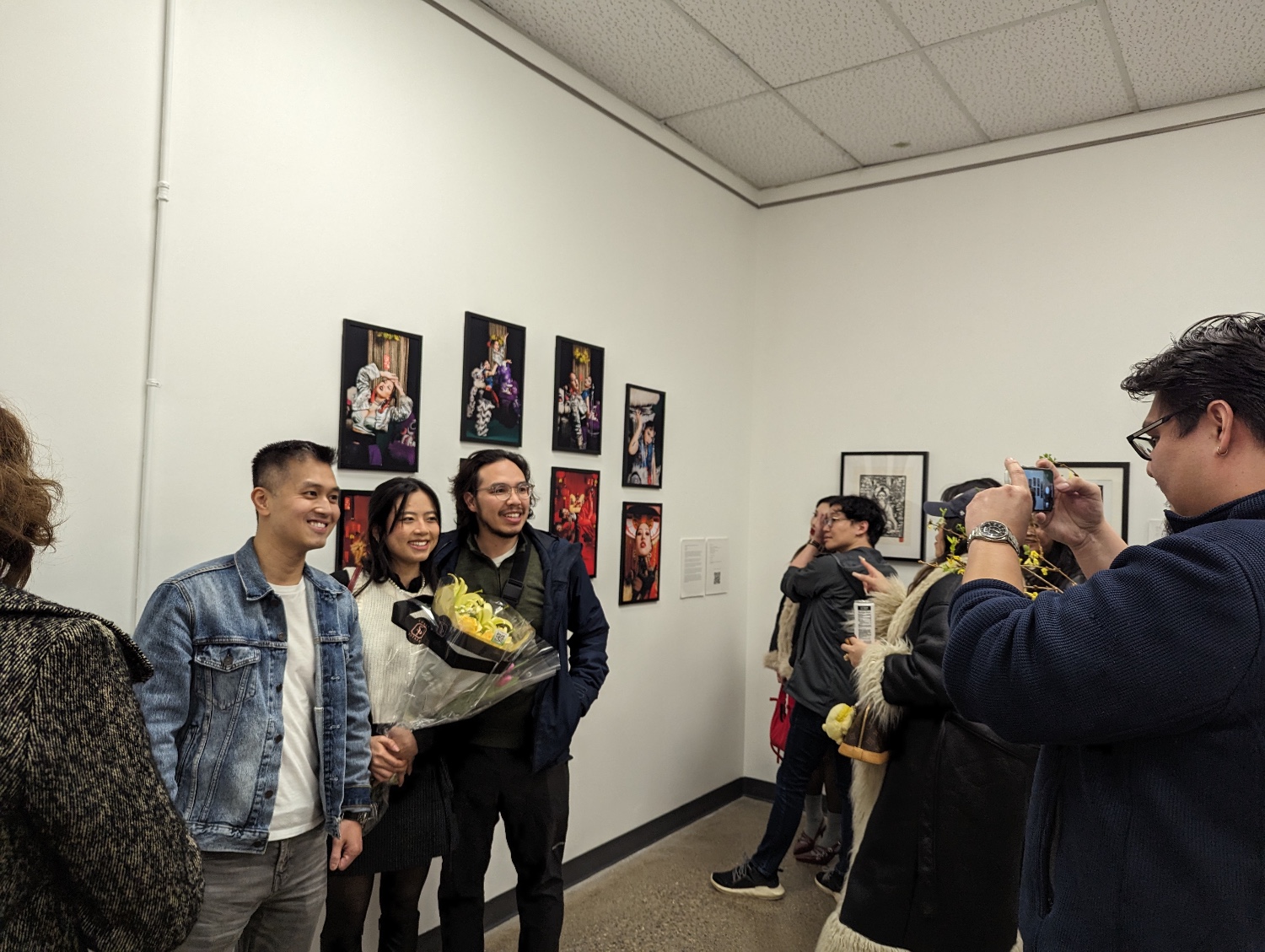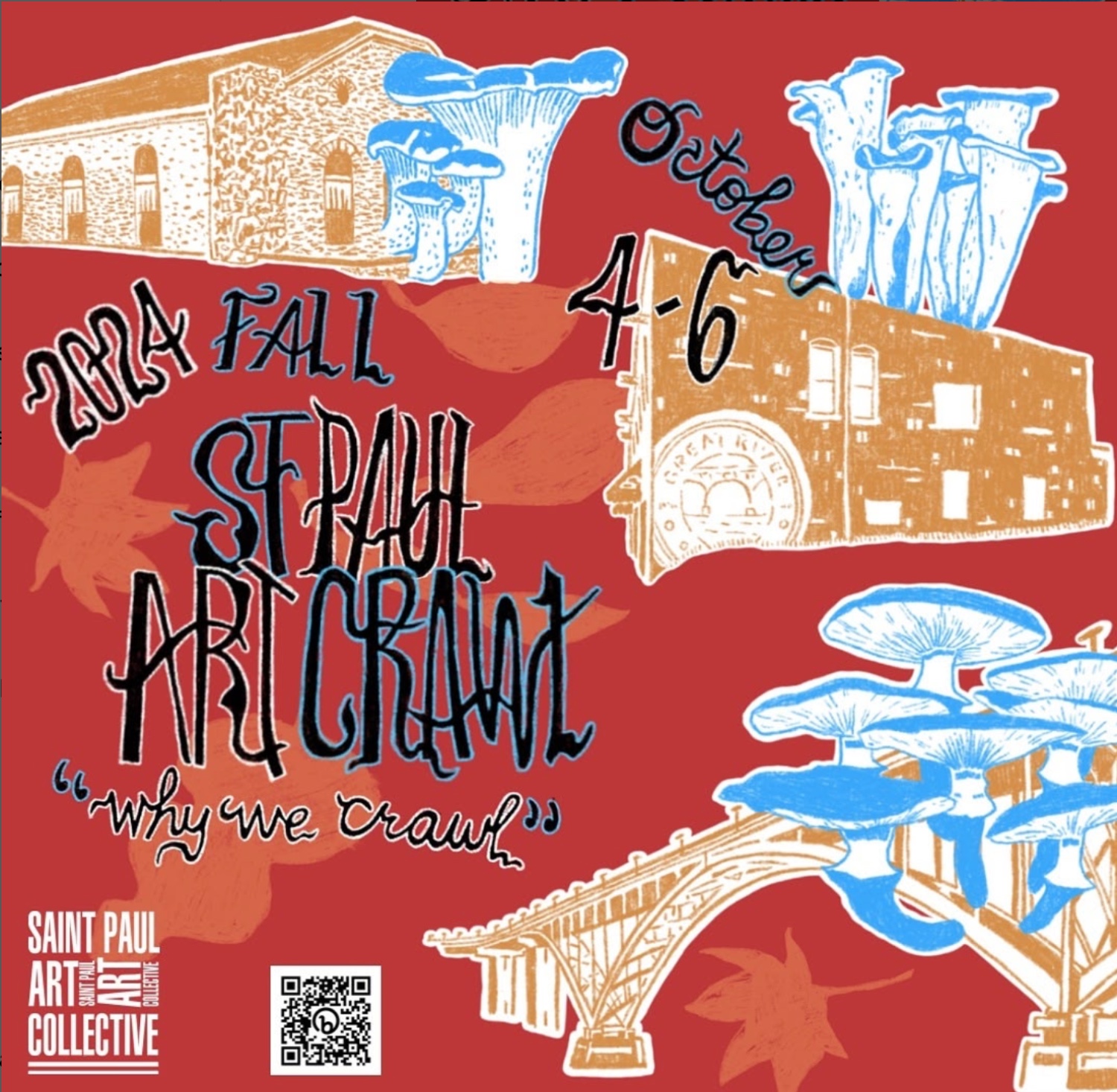
Saint Paul Art Crawl gets a fresh view for Fall
Published September 17th, 2024 by Katie Dohman
Saint Paul Art Collective's new Executive Director Mariusz Kujawski brings experience from around the world as a dancer, choreographer, and arts organizer ahead of the October Crawl

Banner image: Lowertown at the former Black Dog Wine Bar and Cafe. Photo by Mariusz Kujawski.
Mariusz Kujawski is a citizen of the world: Born and raised in Poland, he spent some teen years in Iceland, and then arrived stateside as an exchange student — and stayed. He’s got an artist's pedigree, with a lifetime of training and a degree in dance, plus professional experience. Then, he brought his expertise and curiosity to St. Paul, where his wife is from, first as a volunteer for the St. Paul Art Collective, and now as its newest executive director. Within these first 30 days on the job, he’s guiding the launch of the next St. Paul Art Crawl this fall — October 4, 5, and 6 — and developing his vision for the future of the arts in the capitol city.
We caught up with Kujawski to get the latest. This conversation has been condensed for space and clarity.
 Mariusz Kujawski. Photo by Martha Kirby, courtesy of Mariusz Kujawski.
Mariusz Kujawski. Photo by Martha Kirby, courtesy of Mariusz Kujawski.
Katie Dohman: How did your new job come about?
Mariusz Kujawski: I moved here from NYC with my wife about four years ago. When we moved here, we wanted to look for a community to join, and since we’re both dance artists, we found the SPAC. I joined the crawl for the first year and second year by helping coordinate the buildings, and then I helped coordinate Lowertown the next Crawl. After that, I joined the board. I’ve been on the board for the last two years, and I volunteered for the communications and programming. A big part of programming is the Crawl, too. Then I applied to be executive director.
KD: What was appealing about the St. Paul Art Collective?
MK: The rich history. I like to help artists, and in New York I was volunteering for Dance NYC, where I was the operations and art director. Hearing from the community in Lowertown about the challenges of 2020, I felt like I could add a little expertise on art curation and art organizing.
What was really helpful is that I moved into the Artist Co-op here in Lowertown, which is one of the oldest co-ops in Minnesota. It’s been around since the beginning of the Collective, and one of the first major projects was to help artists find affordable housing, buy the building, and collaborate with artists’ community, Artspace, and the city, building a space where artists can both work and live. I moved in, and right from the get-go, we started talking about organizing the building for the Art Crawl. Artists here start to organize right after the last one ends.
KD: Having lived all over the world, how do you think these towns stack up?
MK: I think the challenge for smaller communities that are rich in culture and diverse in their artists — both in the medium and location — is to connect and bring the community to the forefront. There are a lot of artists and lots of mediums that are right up there, and the talent and awards are here. The challenge is the marketing: Artists in NYC have [bigger] festivals; Miami has Art Basel. This does not include museums and institutions that help with art exchange and culture exchange. These festivals really help with the exposure.
But art is in the forefront in Minnesota.
 Art by Aisling Jelinski at Schmidt Artists Lofts.
Art by Aisling Jelinski at Schmidt Artists Lofts.
KD: MSP really bills themselves as arts towns. With your global perspective, what do you think?
MK: They are [because they know] the arts are critical to social health and economic prosperity. The city of St. Paul has a lot of programs for artists, and there’s new programs that come out on a regular basis, especially in the last couple of years. There will be a lot of cultural corridors built that I think are very important for the health of the community. And we could help connect them.
The city of St. Paul is great. I’m doing this leadership program through St. Paul Area Chamber. They had an opportunity for a scholarship for an artist to join, and I received that scholarship. I’ve been participating in leadership workshops and meeting with the mayor and city officials. I’ve been learning about how press works and how to write a press release, or even make it into a one-pager, to be digestible. Through that program I’ve been able to see the city more and continue to learn.
KD: Minnesota can be a tight community. What do you think your fresh view brings to your new role as executive director?
MK: The tight artist community helped me get involved.
A fresh view: I like that. I want to listen to the community and gather information. I started to reach out by creating a free offering for the nonprofits in the city — a networking event. My last meeting I had about 15 nonprofits, meeting with District 10,11, 825 Arts, the library downtown, Mizz Mercedez Rondo Double Dutch. We had breakfast and talked about how important our youth is in the community and how youth also help older folks feel younger. A mom there talked about how she has teenagers and they are wanting to explore the neighborhood more. She wants to make sure they are safe. The goal was to come up with something and go to the city or grantors with ideas to do that. The idea so far is to create a map where teenagers can open the map and see galleries or music venues that are showing work, coffee shops or restaurants where they can do homework. We are weaving that in with history and how there’s so much history in those neighborhoods. And lots of neighborhoods are already creating programs for youth to learn about that history. A lot of it dispersed and we want to make it so the elders are teaching the youth, and spending time with them, and the youth have places to go, for free. It feels like we’re on the same page and want to connect neighborhoods.
 Photo from Celebrating Lunar New Year Together exhibition at XIA Gallery & Cafe, which will be showing art by Zhi Kai Vanderford in October. Photo courtesy of Mariusz Kujawski.
Photo from Celebrating Lunar New Year Together exhibition at XIA Gallery & Cafe, which will be showing art by Zhi Kai Vanderford in October. Photo courtesy of Mariusz Kujawski.
KD: What’s your own artistic history and how does that feed your current role?
MK: I am a dance choreographer and dancer. And I enjoy putting things on recyclable materials and hanging them on the wall. We can call that art.
In Poland, I did ballroom dancing. When I was 14, I moved to Iceland with my parents. I found a teacher because I was missing it a lot. I trained for a year, and won the youth division for Latin American dancing in the Icelandic championships. Then I moved to the States as an exchange student for a year. There were no ballroom classes in city of Fergus Falls, and I was missing dancing, but there was a dance studio that offered things like jazz, modern, tap, ballet… nothing I was familiar with, but I liked a challenge. I signed up for a few classes and the teachers were inspiring. It was really great to learn new techniques. Coming from knowing a lot about ballroom, I thought I knew a lot about dance, but then you switch the form and I didn’t know anything about dance.
Then one day, my math teacher asked me after class, what are you going to do for college? I didn’t think I was going to go to college. I thought, “Finishing high school is good.” What would I go for, science? I knew English, but continued to learn. Mrs. Zsedeny told me, “You should go for dance.” I didn’t know that was an option! That was life changing. Then, Mary Pettit, my dance teacher at the Fergus Falls School of Dance, took me and her son to Steven’s Point to audition — he auditioned for music and we ended up rooming together — and I was able to go to college for dance and earned my BA in three-and-a-half years. I also met my wife in college, and we moved to New York and worked for and danced for the Zest Collective. I learned a lot about space composition.
The thing about choreography is that there is more to it than teaching steps. It’s how the steps are done, and why. Then there’s the technical part of it: the lighting, the stage, the costumes. Stage managing. You wear a lot of hats. And I think that perspective has helped me with understanding St. Paul. I’m able to take that experience and apply it to help artists here perform and find spaces to perform, sell work, and continue to thrive.
 Art by Lauren Hefty at Friedli Gallery and Studio.
Art by Lauren Hefty at Friedli Gallery and Studio.
KD: What are your goals for the Collective and the St. Paul Art Crawl in the near future?
MK: For the near future, I would like to be able to reconnect with the stakeholders that have been part of the Crawl in the past, strengthen the connections with businesses and artists who are participating in the crawl, promote a range of cultural offerings, and start thinking about the long-term impact of the arts in the city.
KD: What should folks be excited about for the October crawl?
MK: This fall it will all be held on one weekend, October 4 – 6. The idea is to wake everything up. Rejuvenate. Help St. Paul see the beautiful art that’s already here, by putting it at the forefront and promoting it. I’ve been working with music venues to continue to expand into all art forms. And check out the Schmidt Artist Lofts, which are doing Sounds of Schmidt. Gambit Brewery is doing a comedy show! ◼︎
 Poster design by Chanci Art.
Poster design by Chanci Art.
The Saint Paul Art Crawl is taking place October 4, 5, and 6, spanning over 25 locations across the city. For more info, visit stpaulartcollective.org and follow them on Instagram @stpaulartcollective.
We can't do it without you.
Help keep independent arts journalism alive in the Twin Cities.
We can't do it without you.
Help keep independent arts journalism alive in the Twin Cities.